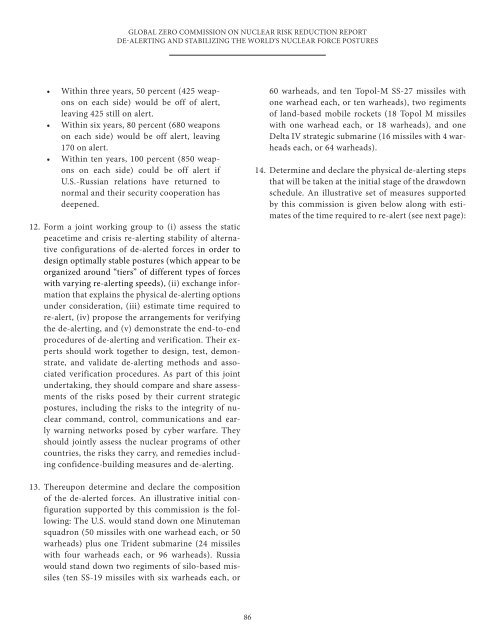global_zero_commission_on_nuclear_risk_reduction_report
global_zero_commission_on_nuclear_risk_reduction_report
global_zero_commission_on_nuclear_risk_reduction_report
You also want an ePaper? Increase the reach of your titles
YUMPU automatically turns print PDFs into web optimized ePapers that Google loves.
GLOBAL ZERO COMMISSION ON NUCLEAR RISK REDUCTION REPORTDE-ALERTING AND STABILIZING THE WORLD’S NUCLEAR FORCE POSTURES• Within three years, 50 percent (425 weap<strong>on</strong>s<strong>on</strong> each side) would be off of alert,leaving 425 still <strong>on</strong> alert.• Within six years, 80 percent (680 weap<strong>on</strong>s<strong>on</strong> each side) would be off alert, leaving170 <strong>on</strong> alert.• Within ten years, 100 percent (850 weap<strong>on</strong>s<strong>on</strong> each side) could be off alert ifU.S.-Russian relati<strong>on</strong>s have returned t<strong>on</strong>ormal and their security cooperati<strong>on</strong> hasdeepened.12. Form a joint working group to (i) assess the staticpeacetime and crisis re-alerting stability of alternativec<strong>on</strong>figurati<strong>on</strong>s of de-alerted forces in order todesign optimally stable postures (which appear to beorganized around “tiers” of different types of forceswith varying re-alerting speeds), (ii) exchange informati<strong>on</strong>that explains the physical de-alerting opti<strong>on</strong>sunder c<strong>on</strong>siderati<strong>on</strong>, (iii) estimate time required tore-alert, (iv) propose the arrangements for verifyingthe de-alerting, and (v) dem<strong>on</strong>strate the end-to-endprocedures of de-alerting and verificati<strong>on</strong>. Their expertsshould work together to design, test, dem<strong>on</strong>strate,and validate de-alerting methods and associatedverificati<strong>on</strong> procedures. As part of this jointundertaking, they should compare and share assessmentsof the <strong>risk</strong>s posed by their current strategicpostures, including the <strong>risk</strong>s to the integrity of <strong>nuclear</strong>command, c<strong>on</strong>trol, communicati<strong>on</strong>s and earlywarning networks posed by cyber warfare. Theyshould jointly assess the <strong>nuclear</strong> programs of othercountries, the <strong>risk</strong>s they carry, and remedies includingc<strong>on</strong>fidence-building measures and de-alerting.60 warheads, and ten Topol-M SS-27 missiles with<strong>on</strong>e warhead each, or ten warheads), two regimentsof land-based mobile rockets (18 Topol M missileswith <strong>on</strong>e warhead each, or 18 warheads), and <strong>on</strong>eDelta IV strategic submarine (16 missiles with 4 warheadseach, or 64 warheads).14. Determine and declare the physical de-alerting stepsthat will be taken at the initial stage of the drawdownschedule. An illustrative set of measures supportedby this <str<strong>on</strong>g>commissi<strong>on</strong></str<strong>on</strong>g> is given below al<strong>on</strong>g with estimatesof the time required to re-alert (see next page):13. Thereup<strong>on</strong> determine and declare the compositi<strong>on</strong>of the de-alerted forces. An illustrative initial c<strong>on</strong>figurati<strong>on</strong>supported by this <str<strong>on</strong>g>commissi<strong>on</strong></str<strong>on</strong>g> is the following:The U.S. would stand down <strong>on</strong>e Minutemansquadr<strong>on</strong> (50 missiles with <strong>on</strong>e warhead each, or 50warheads) plus <strong>on</strong>e Trident submarine (24 missileswith four warheads each, or 96 warheads). Russiawould stand down two regiments of silo-based missiles(ten SS-19 missiles with six warheads each, or86


